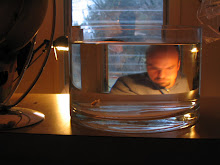Remember when Jennifer Lawrence, approaching the Academy Awards stage in a long, elegant dress, stumbled on a stair? And remember her disarmingly candid reaction, and the general swell of support that met her as a result? There's something quite refreshing, it seems, when a polished and seemingly invulnerable celebrity momentarily becomes all too human. Stars, one celebrity magazine reminds us, are just like us: they balance groceries precariously in the dairy aisle, and they sometimes emerge all too awkwardly from their hatchbacks. Or, like Pearl Jam's Eddie Vedder at the 3:59 mark in the video that helped to make that band famous, they experience a visible doubt about the situation into which they've gotten themselves. And, in the process, they remind us of our shared fallibility - and thus, too, of our common humanity.
But of course not only celebrities have this power. I'm thinking, too, of 8-year-old Elizabeth Hughes, a budding singer who had been asked to sing the national anthem at a Norfolk hockey game - and then, in her nervousness, forgot the words. One fan reacted by laughing immodestly, but the rest of the crowd - well, you can hear their reaction for yourself, if you'd like (it's at the 1:30 mark). In some cases, a public mistake can warm the heart.
Cleo's not a celebrity, and she hasn't sung the national anthem in public yet. (Although she does like to try to impress new acquaintances with a rendition of the pledge of allegiance: 'and to the republic for Richard stands...'). But she does have, like most 4-year-olds, a stridently confident sense of self, a general assumption that she can do everything. And so, as she and I played miniature golf recently in Austin, TX, and she struggled with the steep slopes of one hole, it was somehow touching to see her softly mocking her troubles with the ball. 'Gah!' she says, as she marches after the misbehaving ball 'That was silly.' Sounding momentarily like Bridget Jones, Cleo is, in the video above, simultaneously lovely and aware of the limits of her loveliness. Or, as she might put it, she is both Wonder Woman and little girl. And I love her for it.












